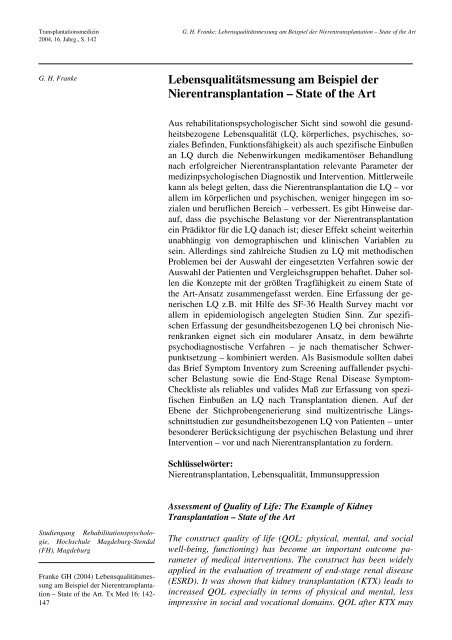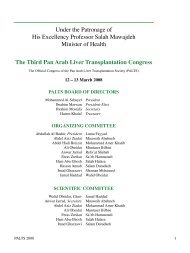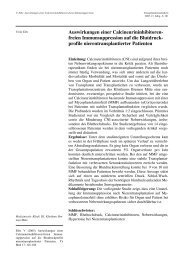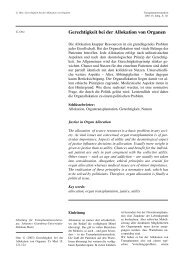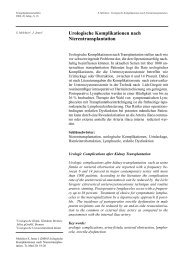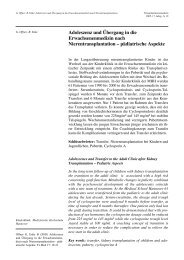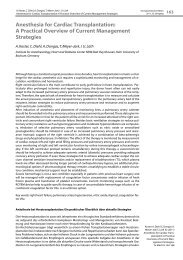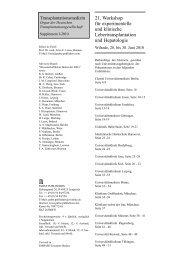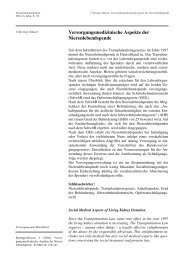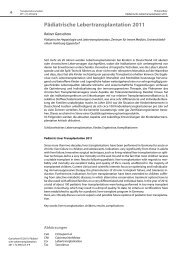Lebensqualitätsmessung am Beispiel der Nierentransplantation ...
Lebensqualitätsmessung am Beispiel der Nierentransplantation ...
Lebensqualitätsmessung am Beispiel der Nierentransplantation ...
Sie wollen auch ein ePaper? Erhöhen Sie die Reichweite Ihrer Titel.
YUMPU macht aus Druck-PDFs automatisch weboptimierte ePaper, die Google liebt.
Transplantationsmedizin<br />
2004, 16. Jahrg., S. 142<br />
G. H. Franke: Lebensqualitätsmessung <strong>am</strong> <strong>Beispiel</strong> <strong>der</strong> <strong>Nierentransplantation</strong> – State of the Art<br />
G. H. Franke<br />
Lebensqualitätsmessung <strong>am</strong> <strong>Beispiel</strong> <strong>der</strong><br />
<strong>Nierentransplantation</strong> – State of the Art<br />
Aus rehabilitationspsychologischer Sicht sind sowohl die gesundheitsbezogene<br />
Lebensqualität (LQ, körperliches, psychisches, soziales<br />
Befinden, Funktionsfähigkeit) als auch spezifische Einbußen<br />
an LQ durch die Nebenwirkungen medik<strong>am</strong>entöser Behandlung<br />
nach erfolgreicher <strong>Nierentransplantation</strong> relevante Par<strong>am</strong>eter <strong>der</strong><br />
medizinpsychologischen Diagnostik und Intervention. Mittlerweile<br />
kann als belegt gelten, dass die <strong>Nierentransplantation</strong> die LQ – vor<br />
allem im körperlichen und psychischen, weniger hingegen im sozialen<br />
und beruflichen Bereich – verbessert. Es gibt Hinweise darauf,<br />
dass die psychische Belastung vor <strong>der</strong> <strong>Nierentransplantation</strong><br />
ein Prädiktor für die LQ danach ist; dieser Effekt scheint weiterhin<br />
unabhängig von demographischen und klinischen Variablen zu<br />
sein. Allerdings sind zahlreiche Studien zu LQ mit methodischen<br />
Problemen bei <strong>der</strong> Auswahl <strong>der</strong> eingesetzten Verfahren sowie <strong>der</strong><br />
Auswahl <strong>der</strong> Patienten und Vergleichsgruppen behaftet. Daher sollen<br />
die Konzepte mit <strong>der</strong> größten Tragfähigkeit zu einem State of<br />
the Art-Ansatz zus<strong>am</strong>mengefasst werden. Eine Erfassung <strong>der</strong> generischen<br />
LQ z.B. mit Hilfe des SF-36 Health Survey macht vor<br />
allem in epidemiologisch angelegten Studien Sinn. Zur spezifischen<br />
Erfassung <strong>der</strong> gesundheitsbezogenen LQ bei chronisch Nierenkranken<br />
eignet sich ein modularer Ansatz, in dem bewährte<br />
psychodiagnostische Verfahren – je nach thematischer Schwerpunktsetzung<br />
– kombiniert werden. Als Basismodule sollten dabei<br />
das Brief Symptom Inventory zum Screening auffallen<strong>der</strong> psychischer<br />
Belastung sowie die End-Stage Renal Disease Symptom-<br />
Checkliste als reliables und valides Maß zur Erfassung von spezifischen<br />
Einbußen an LQ nach Transplantation dienen. Auf <strong>der</strong><br />
Ebene <strong>der</strong> Stichprobengenerierung sind multizentrische Längsschnittstudien<br />
zur gesundheitsbezogenen LQ von Patienten – unter<br />
beson<strong>der</strong>er Berücksichtigung <strong>der</strong> psychischen Belastung und ihrer<br />
Intervention – vor und nach <strong>Nierentransplantation</strong> zu for<strong>der</strong>n.<br />
Schlüsselwörter:<br />
<strong>Nierentransplantation</strong>, Lebensqualität, Immunsuppression<br />
Assessment of Quality of Life: The Ex<strong>am</strong>ple of Kidney<br />
Transplantation – State of the Art<br />
Studiengang Rehabilitationspsychologie,<br />
Hochschule Magdeburg-Stendal<br />
(FH), Magdeburg<br />
Franke GH (2004) Lebensqualitätsmessung<br />
<strong>am</strong> <strong>Beispiel</strong> <strong>der</strong> <strong>Nierentransplantation</strong><br />
– State of the Art. Tx Med 16: 142-<br />
147<br />
The construct quality of life (QOL; physical, mental, and social<br />
well-being, functioning) has become an important outcome par<strong>am</strong>eter<br />
of medical interventions. The construct has been widely<br />
applied in the evaluation of treatment of end-stage renal disease<br />
(ESRD). It was shown that kidney transplantation (KTX) leads to<br />
increased QOL especially in terms of physical and mental, less<br />
impressive in social and vocational domains. QOL after KTX may
G. H. Franke: Lebensqualitätsmessung <strong>am</strong> <strong>Beispiel</strong> <strong>der</strong> <strong>Nierentransplantation</strong> – State of the Art Transplantationsmedizin<br />
2004, 16. Jahrg., S. 143<br />
be predicted from mental distress before KTX, independently from<br />
clinical or sociodemografic variables. Studies concerning QOL in<br />
ESRD vary in their methodological standard as to the psychodiagnostic<br />
instruments, the s<strong>am</strong>ple and controls. State of the art studies<br />
exploring QOL in ESRD should consi<strong>der</strong> an approach to the s<strong>am</strong>ple<br />
and selection of psychodiagnostic instruments providing evidence<br />
for the question specifically asked. Exploration of generic<br />
QOL in epidemiological studies may be carried out by the Short<br />
Form 36-Health Survey. A modular approach may best meet criteria<br />
for assessment of disease-specific QOL in ESRD, and should<br />
include validated psychodiagnostic inventories according to the<br />
specific question. It is recommended to apply the Brief Symptom<br />
Inventory as screening instrument for mental distress as well as<br />
the End-Stage Renal Disease Symptom Checklist as tool for<br />
evaluation of transplantation-related QOL(-impairment). Multicentre<br />
longitudinal studies in a pre-post design are recommended<br />
for s<strong>am</strong>ple generation with special respect to mental distress and<br />
outcomes of interventions.<br />
Key words:<br />
kidney transplantation, quality of life, immunosuppression<br />
Einleitung<br />
Die <strong>Nierentransplantation</strong> ist mittlerweile<br />
ein Standardverfahren <strong>der</strong> Nierenersatztherapie<br />
mit Ein-Jahres-<br />
Überlebensraten von 95% bei Lebendund<br />
>88% bei herkömmlicher Organspende<br />
geworden (1). Daher liegt es<br />
nahe, den Fokus <strong>der</strong> wissenschaftlichen<br />
Forschung stärker auf die gesundheitsbezogene<br />
Lebensqualität <strong>der</strong> betroffenen<br />
Patientinnen und Patienten zu legen.<br />
Die Lebensqualitätsforschung berücksichtigt<br />
bei <strong>der</strong> Erfassung <strong>der</strong> Auswirkungen<br />
von Erkrankungen und/o<strong>der</strong><br />
<strong>der</strong>en Behandlung explizit den Blickwinkel<br />
<strong>der</strong> Betroffenen. Die vier Komponenten<br />
physisches, psychisches und<br />
soziales Befinden sowie Funktionsfähigkeit<br />
finden sich durchgängig in <strong>der</strong><br />
internationalen Literatur und können<br />
womöglich als kulturübergreifende Par<strong>am</strong>eter<br />
gelten (2). Die psychodiagnostische<br />
Erfassung von Lebensqualität<br />
sollte sich primär auf den Selbstbeurteilungsansatz<br />
stützen, da Fremdbeurteiler<br />
eine an<strong>der</strong>e Perspektive einnehmen und<br />
somit ihre Aussagen nicht mit Selbstbeurteilungsdaten<br />
gleichzusetzen sind<br />
(3-4). Selbstverständlich können<br />
Fremdbeurteilungen – in Abhängigkeit<br />
von spezifischen Fragestellungen wie<br />
<strong>der</strong> nach <strong>der</strong> Arbeitsfähigkeit (5) – ergänzend<br />
erhoben werden.<br />
Auf methodischer Ebene ist bis heute<br />
ein Mangel an Längsschnittstudien zu<br />
beklagen (6). Dew et al. (7) analysierten<br />
66 Studien an 6726 Empfängern von<br />
Nierentransplantaten und fanden, dass<br />
ca. 80% im körperlichen und psychischen,<br />
aber nur 60% im sozialen Bereich<br />
eine Verbesserung nach Transplantation<br />
berichteten. Allerdings sind<br />
die <strong>der</strong> Meta-Analyse zugrunde liegenden<br />
Studien oftmals mit z.T. vermeidbaren<br />
methodischen Problemen in Bezug<br />
auf die Auswahl von psychodiagnostischen<br />
Verfahren sowie von Patienten-<br />
und Vergleichsgruppen behaftet<br />
(4, 8). Der Einsatz von Verfahren zur<br />
Untersuchung <strong>der</strong> Allgemeinbevölkerung<br />
führte z.B. dazu, dass transplantierte<br />
Patienten eine bessere Lebensqualität<br />
berichteten als die Allgemeinbevölkerung<br />
selbst (9-12). Der Einsatz<br />
solcher Verfahren wurde daher auch<br />
kritisiert (13-14).<br />
Problematisch ist es ebenso, dass verschiedene<br />
Studienzentren unterschiedliche<br />
Verfahren einsetzen, so dass ein<br />
Vergleich <strong>der</strong> so gewonnenen Ergebnisse<br />
unnötig erschwert wird. Unter Umständen<br />
führt die Auswahl <strong>der</strong> psychodiagnostischen<br />
Verfahren sogar dazu,<br />
dass in <strong>der</strong> gleichen Studiengruppe divergierende<br />
Ergebnisse gefunden werden<br />
(15). Vergleicht man nun die gesundheitsbezogene<br />
Lebensqualität von<br />
Dialysepatienten mit bereits Transplantierten,<br />
haben auch hier schon Stichprobenselektionen<br />
stattgefunden, die zu<br />
verzerrten Ergebnissen führen werden,<br />
da nur transplantable und somit gesün<strong>der</strong>e<br />
Dialysepatienten auf die Warteliste<br />
gelangen. Ebenso beeinflussen die demografischen<br />
Variablen Alter und Geschlecht<br />
das Antwortprofil; denn Frauen<br />
und ältere Menschen mit terminaler<br />
Niereninsuffizienz beschreiben im<br />
Durchschnitt eine geringere gesundheitsbezogene<br />
Lebensqualität (6, 16);<br />
gleichzeitig schließt ein höheres Alter<br />
(>=60 J. o<strong>der</strong> >=65 J.) die erfolgreiche<br />
<strong>Nierentransplantation</strong> nicht aus (17,<br />
18). Auf medizinischer Ebene muss vor<br />
allem das Vorliegen von Diabetes als<br />
negativer Prädiktor <strong>der</strong> gesundheitsbezogenen<br />
Lebensqualität gelten (19),<br />
wobei hier die simultane Pankreas-<br />
<strong>Nierentransplantation</strong> zu ermutigenden<br />
Verbesserungen vor allem <strong>der</strong> diabetesspezifischen<br />
Einbußen an gesundheitsbezogener<br />
Lebensqualität führen kann<br />
(20-22).<br />
Prinzipiell gilt es, generische bzw. allgemeine<br />
und erkrankungsspezifische<br />
psychodiagnostische Verfahren zur Erfassung<br />
<strong>der</strong> gesundheitsbezogenen Lebensqualität<br />
zu unterscheiden.<br />
Generische Verfahren zur<br />
Erfassung <strong>der</strong> gesundheitsbezogenen<br />
Lebensqualität<br />
Generische, krankheitsübergreifende<br />
Verfahren wie <strong>der</strong> Short-Form-36<br />
Health Survey (23) o<strong>der</strong> das Nottingh<strong>am</strong><br />
Health Profile (24, 25) eignen sich<br />
vor allem für Screening-Untersuchungen<br />
bzw. für epidemiologisch orientierte<br />
Studien, da sie einen Vergleich <strong>der</strong><br />
gesundheitsbezogenen Lebensqualität<br />
von verschiedenen Populationen erlauben<br />
(26). Einzelne Autoren (27) sprechen<br />
sich zwar für den Einsatz des Nottingh<strong>am</strong><br />
Health Profile zur Untersuchung<br />
chronisch Nierenkranker im Gegensatz<br />
zum Sickness Impact Profile<br />
(28) aus, das eher ein funktionales Maß<br />
darstellt (29). Eine Medline-Recherche<br />
erbrachte nur drei Eintragungen von<br />
Studien, in denen das Sickness Impact<br />
Profile bei Nierentransplantierten herangezogen<br />
wurde; je eine davon
Transplantationsmedizin<br />
2004, 16. Jahrg., S. 144<br />
G. H. Franke: Lebensqualitätsmessung <strong>am</strong> <strong>Beispiel</strong> <strong>der</strong> <strong>Nierentransplantation</strong> – State of the Art<br />
st<strong>am</strong>mte von einer deutschen (30), einer<br />
nie<strong>der</strong>ländischen (31) und einer US<strong>am</strong>erikanischen<br />
(32) Arbeitsgruppe.<br />
Die SF-36 umfasst acht Subskalen, die<br />
zu zwei Hauptkomponenten zus<strong>am</strong>mengefasst<br />
werden:<br />
Der Körperliche Summenscore umfasst<br />
die Subskalen<br />
1. Körperliche Funktionsfähigkeit<br />
2. Körperliche Rollenfunktion<br />
3. Körperlicher Schmerz<br />
4. Allgemeine Gesundheitswahrnehmung<br />
Der Psychische Summenscore integriert<br />
die Subskalen<br />
5. Vitalität<br />
6. Soziale Funktionsfähigkeit<br />
7. Emotionale Rollenfunktion<br />
8. Psychisches Wohlbefinden.<br />
Zus<strong>am</strong>mengefasst wird auf internationaler<br />
Ebene zur Untersuchung von Nierentransplantierten<br />
vor allem <strong>der</strong> SF-36<br />
eingesetzt (exemplarisch 33), verschiedene<br />
Arbeitsgruppen for<strong>der</strong>n explizit<br />
zur Nutzung dieses Verfahrens auf (34,<br />
35, 20); an<strong>der</strong>e Autoren geben zu bedenken,<br />
dass interkulturelle Unterschiede<br />
den Vergleich <strong>der</strong> Antworten auch<br />
bei <strong>der</strong> SF-36 problematisch werden<br />
lassen (37). Beson<strong>der</strong>s auffallend ist es,<br />
dass auch im Einsatz <strong>der</strong> SF-36 in einer<br />
Studie an nierentransplantierten Patienten,<br />
die älter als 65 Jahre waren, Werte<br />
erreicht wurden, die höher lagen als die<br />
von gesunden Vergleichsgruppen (37).<br />
An<strong>der</strong>e Arbeitsgruppen wiesen darauf<br />
hin, dass Spen<strong>der</strong> im SF-36 ebenfalls<br />
bessere Werte als gesunde Vergleichsgruppen<br />
erzielten (38-40) – eine abschließende<br />
Bewertung solcher Effekte<br />
steht allerdings bislang noch aus.<br />
Verfahren zur Erfassung <strong>der</strong><br />
psychischen Belastung<br />
Zur kurzen und knappen Erfassung <strong>der</strong><br />
psychischen Belastung kann bei Nierentransplantierten<br />
sehr gut das Brief<br />
Symptom Inventory (41-42) eingesetzt<br />
(4, 43-51). Diese 53 Fragen umfassende<br />
Checkliste bietet ausgewertet einen<br />
standardisierten Überblick über die aktuelle<br />
symptomatische Belastung in Bezug<br />
auf verschiedene, psychologisch relevante<br />
Skalen und drei globale Kennwerte.<br />
Der beson<strong>der</strong>e Vorteil des Verfahrens<br />
liegt zum einen darin begründet,<br />
dass deutschsprachige Stichproben<br />
niereninsuffizienter sowie nierentransplantierter<br />
Patienten vorliegen (41). Auf<br />
<strong>der</strong> an<strong>der</strong>en Seite konnte nachgewiesen<br />
werden, dass die psychische Belastung<br />
vor <strong>Nierentransplantation</strong> – gemessen<br />
mit dem Brief Symptom Inventory –<br />
die gesundheitsbezogene Lebensqualität<br />
nach erfolgreicher Transplantation vorhersagen<br />
kann (4, 43). Diese Vorhersagekraft<br />
beläuft sich auf bis zu 25% Varianzaufklärung<br />
und sie ist unabhängig<br />
von soziodemographischen und klinischen<br />
Daten. Somit scheint <strong>der</strong> psychischen<br />
Belastung im Kanon <strong>der</strong> vier<br />
Teilbereiche <strong>der</strong> gesundheitsbezogenen<br />
Lebensqualität ein herausragen<strong>der</strong> Stellenwert<br />
zuzukommen.<br />
Verfahren zur Erfassung<br />
<strong>der</strong> erkrankungsspezifischen<br />
Lebensqualität Nierentransplantierter<br />
Die End-Stage Renal Disease Symptom<br />
Checklist – Transplantation Module<br />
(ESRD-SCL-TM, 52-53) kann als reliables<br />
und valides Instrument zur Erfassung<br />
<strong>der</strong> erkrankungsspezifischen Lebensqualität<br />
von Nierentransplantierten<br />
gelten. Die Checkliste umfasst 45 Items<br />
zu körperlicher und psychischer symptomatischer<br />
Belastung bei einer fünfstufigen<br />
Likert-Skala (range von 0 =<br />
„überhaupt nicht“ bis 4 = „sehr stark),<br />
die zu den folgenden sechs Skalen zus<strong>am</strong>mengefasst<br />
werden:<br />
1. Eingeschränkte körperlicher Leistungsfähigkeit:<br />
Zehn Fragen beleuchten<br />
Gelenk-, Knochen-, Muskel-,<br />
Magen- o<strong>der</strong> Kopfschmerzen,<br />
Erschöpfung, Schwindel, Erkältung<br />
sowie einen schlechten Gesundheitszustand<br />
und eine eingeschränkte<br />
körperliche Leistungsfähigkeit<br />
2. Eingeschränkte kognitive Leistungsfähigkeit:<br />
Acht Fragen thematisieren<br />
Vergesslichkeit, Konzentrationsschwierigkeiten,<br />
Erinnerungsstörungen,<br />
Nervosität, verschlechtertes<br />
Hör- und Sehvermögen sowie<br />
eine eingeschränkte geistige Leistungsfähigkeit<br />
3. Kardiale und renale Dysfunktion:<br />
Sieben Fragen umfassen geschwollene<br />
Füße und Beine, Bluthochdruck,<br />
Herzrhythmusstörungen, die<br />
Neigung zu blauen Flecken sowie<br />
vermehrten Durst<br />
4. Kortisonnebenwirkungen: Fünf<br />
Items beleuchten das geschwollene<br />
o<strong>der</strong> aufgequollene Gesicht, Gewichtsverän<strong>der</strong>ungen<br />
sowie verän<strong>der</strong>tes<br />
Aussehen und eine verstärkte<br />
Infektionsneigung<br />
5. Verstärkter Haar- und Zahnfleischwuchs:<br />
Fünf Items thematisieren<br />
Wucherungen, Blutungen und Verän<strong>der</strong>ungen<br />
des Zahnfleisches sowie<br />
vermehrten Haarwuchs und<br />
verstärkte Körperbehaarung<br />
6. Transplantationsassoziierte psychische<br />
Belastung: Acht Items umfassen<br />
Gedanken und Sorgen in Bezug<br />
auf die Transplantation, den Spen<strong>der</strong><br />
sowie die Funktionsfähigkeit<br />
des Transplantats, Schlafstörungen<br />
und Alpträume, Stimmungsschwankungen,<br />
Missstimmungen und<br />
Angstzustände.<br />
Exemplarische Anwendung<br />
eines erkrankungsspezifischen<br />
Verfahrens zur<br />
Erfassung <strong>der</strong> Auswirkungen<br />
<strong>der</strong> Immunsuppression<br />
Steroide, Ciclosporin und Tacrolimus<br />
sind die gebräuchlichsten Basisimmunsuppressiva<br />
nach <strong>Nierentransplantation</strong>,<br />
die häufig mit adjunktiven Immunsuppressiva<br />
wie z.B. Mycophenolat<br />
Mofetil, Antikörpern o<strong>der</strong> Azathioprin<br />
kombiniert werden. Die Auswirkungen<br />
dieser Immunsuppression auf die gesundheitsbezogene<br />
Lebensqualität <strong>der</strong><br />
Patienten ist ein Bereich, dem sich die<br />
wissenschaftliche Forschung in Zukunft<br />
verstärkt widmen muss (54).<br />
Betrachtet man rein medizinische Par<strong>am</strong>eter<br />
wie die Abstoßungsrate, so<br />
konnte bislang in mehreren großen multizentrischen<br />
Studien nachgewiesen<br />
werden, dass unter Tacrolimus- im<br />
Vergleich zur Ciclosporintherapie statistisch<br />
signifikant weniger Abstoßungen<br />
auftraten (55 – 59); weiterhin wurden<br />
kardiovaskuläre Nebenwirkungen<br />
(60) sowie Cholesterinspiegel und<br />
Blutdruck reduziert (61). Auch bildeten<br />
sich die unter Ciclosporintherapie auftretenden<br />
kosmetischen Nebenwirkungen<br />
wie Gingivahyperplasie und Hypertrichose<br />
nach Umstellung auf Tacrolimus<br />
beinahe vollständig zurück. (62).<br />
Die positiven Auswirkungen <strong>der</strong> Zurückbildung<br />
dieser kosmetischen Nebenwirkungen<br />
führten in einer weiteren<br />
Studie zu einer verbesserten Zufrieden-
G. H. Franke: Lebensqualitätsmessung <strong>am</strong> <strong>Beispiel</strong> <strong>der</strong> <strong>Nierentransplantation</strong> – State of the Art Transplantationsmedizin<br />
2004, 16. Jahrg., S. 145<br />
Positive Effekte <strong>der</strong> Umstellung von Ciclosporin auf Tacrolimus<br />
Kardiovaskuläre (Hyperlipidämie, Hypertension, n=26), kosmetische Umstellungsgründe<br />
(Gingivahyperplasie, Hypertrichose, n=38)<br />
1,5<br />
1<br />
0,5<br />
0<br />
Ausmaß <strong>der</strong> Belastung (0="überhaupt nicht" bis 4="sehr stark")<br />
Kardiale+renale Dysfunktion* Haar-+Zahnfleischwuchs*** Globaler Wert erkrankungsspez. LQ**<br />
*=p
Transplantationsmedizin<br />
2004, 16. Jahrg., S. 146<br />
G. H. Franke: Lebensqualitätsmessung <strong>am</strong> <strong>Beispiel</strong> <strong>der</strong> <strong>Nierentransplantation</strong> – State of the Art<br />
von Patienten – unter beson<strong>der</strong>er Berücksichtigung<br />
<strong>der</strong> psychischen Belastung<br />
und ihrer Intervention – vor und<br />
nach <strong>Nierentransplantation</strong> zu for<strong>der</strong>n<br />
(6).<br />
Literatur<br />
1. Andrews PA (2002) Renal transplantation. BMJ<br />
324: 530-4<br />
2. Spilker B (Ed.) (1996) Quality of life and pharmacoeconomics<br />
in clinical trials (2nd ed.).<br />
Philadelphia: Lippincott-Raven<br />
3. Hays RD, Vickrey BG, Hermann BP, Perrine K,<br />
Cr<strong>am</strong>er J, Meador K, Spritzer K, Devinsky O<br />
(1995) Agreement between self reports and<br />
proxy reports of quality of life in epilepsy patients.<br />
Qual Life Res 4: 159-168<br />
4. Franke GH, Reimer J, Hessel A, Philipp Th,<br />
Heemann U (2002) Lebensqualitätsforschung<br />
an chronisch Nierenkranken unter beson<strong>der</strong>er<br />
Berücksichtigung <strong>der</strong> psychischen Belastung. Z<br />
Med Psychol 11: 113-120<br />
5. Schag CC, Heinrich RL, Ganz PA (1984) Karnofsky<br />
performance status revisited: Reliability,<br />
validity and guidelines. J Clin Oncology 2: 187-<br />
193<br />
6. Kaplan De-Nour A, Brickman AL (1996) Determining<br />
quality of life in the renal replacement<br />
therapies. In: Spilker B (Ed.) Quality of<br />
Life and Pharmacoeconomics in Clinical Trials<br />
(pp. 953-960). Philadelphia: Lippincott-Raven<br />
7. Dew MA, Switzer GE, Goycoolea JM, Allen AS,<br />
DiMartini A, Kormos RL, Griffith BP (1997)<br />
Does transplantation produce quality of life<br />
benefits? Transplantation 64: 1261-1273<br />
8. Hardt J, Filipas D (2000) Lebensqualitätsforschung<br />
in <strong>der</strong> Urologie – lohnt die Mühe? Aktuel<br />
Urol 31: 157-162<br />
9. Barrett BJ, Vavasour HM, Major A, Parfrey PS<br />
(1990) Clinical and psychological correlates of<br />
somatic symptoms in patients on dialysis. Nephron<br />
55: 10-15<br />
10. Evans RW (1991) Recombinant human erythropoietin<br />
and the quality of life of end-stage renal<br />
disease patients: A comparative analysis. A J<br />
Kidney Dis 18: 62-70<br />
11. Deniston OL, Carpentier-Alting P, Kneisley J,<br />
Hawthorne VM, Port FK (1989) Assessment of<br />
quality of life in end-stage renal disease. Health<br />
Serv Res 24: 555-578<br />
12. Simmons RG, An<strong>der</strong>son CR, Abress LK (1990)<br />
Quality of life and rehabilitation differences<br />
<strong>am</strong>ong four end-stage renal disease therapy<br />
groups. Scand J Urol Nephrol 131: 7-22<br />
13. Kurtin P, Nissenson AR (1993) Variation in<br />
end-stage renal disease patient outcomes: What<br />
we know, what should we know, and how do we<br />
find it out? J Am Soc Nephrol 3: 1738-1747<br />
14. Sensky T (1988) Measurement of the quality of<br />
life in end-stage renal failure. N Engl J Med<br />
319: 1353<br />
15. Laupacis A, Wong C, Churchill D, The Canadian<br />
Erythropoietin Study Group (1991) The<br />
use of generic and specific quality-of-life measures<br />
in hemodialysis patients treated with erythropoietin.<br />
Control Clin Trials 12: 168-179<br />
16. McCauley J, Irish W, Thompson L, Stevenson J,<br />
Lockett R, Bussard R, Washington M (1997)<br />
Factors determining the rate of referral, transplantation,<br />
and survival on dialysis in women<br />
with ESRD. Am J Kidney Dis 30: 739-748<br />
17. Benedetti E, Matas AJ, Hakim N et al. (1994)<br />
Renal transplantation for patients 60 years or<br />
ol<strong>der</strong>. A single-institution experience. Ann Surg<br />
220: 445-8<br />
18. Jassal SV, Krahn MD, Naglie G et al. (2003)<br />
Kidney transplantation in the el<strong>der</strong>ly: A decision<br />
analysis. J Am Soc Nephrol 14: 187-196<br />
19. Baiardi F, Esposti ED, Cocchi R et al. (2002)<br />
Effects of clinical and individual variables on<br />
quality of life in chronic renal failure patients. J<br />
Nephrol 15: 61-7<br />
20. Piehlmeier W, Bullinger M, Kirchberger I, Land<br />
W, Landgraf R (1996) Evaluation of the quality<br />
of life of patients with insulin-dependent diabetes<br />
mellitus before and after organ transplantation<br />
with the SF-36 health survey. Eur J Surg<br />
162: 933-40<br />
21. Gross CR, Limwattananon C, Matthees B, Zehrer<br />
JL, Savik K (2000) Impact of transplantation<br />
on quality of life in patients with diabetes<br />
and renal dysfunction. Transplantation 27:<br />
1736-46<br />
22. Sureshkumar KK, Mubin T, Mikhael N, Kashif<br />
MA, Nghiem DD, Marcus RJ (2002) Assessment<br />
of quality of life after simultaneous pancreaskidney<br />
transplantation. Am J Kidney Dis 39:<br />
1300-6<br />
23. Bullinger M, Kirchberger I (1998) SF-36 Fragebogen<br />
zum Gesundheitszustand, Handanweisung.<br />
Göttingen: Hogrefe<br />
24. Hunt SM, McKenna SP, McEwen J, Willi<strong>am</strong>s J,<br />
Papp E (1981) The Nottingh<strong>am</strong> Health Profile:<br />
Subjective health status and medical consultations.<br />
Social Science and Medicine 15: 221-229<br />
25. Kohlmann T, Bullinger M, Kirchberger-<br />
Blumstein I (1997) Die deutsche Version des<br />
Nottingh<strong>am</strong> Health Profile (NHP): Übersetzungsmethodik<br />
und psychometrische Validierung.<br />
Sozial- und Präventivmedizin 42: 175-185<br />
26. Steinbüchel Nv, Bullinger M, Kirchberger I<br />
(1999) Die Münchener Lebensqualitäts-<br />
Dimensionen-Liste (MLDL). Entwicklung und<br />
Prüfung eines Verfahrens zu krankheitsübergreifen<strong>der</strong><br />
Erfassung von Lebensqualität. Z<br />
Med Psychol 8: 99-112<br />
27. Essink-Bot ML, Krabbe PFM, van Agt HME,<br />
Bonsel GJ (1996) NHP or SIP: A comparative<br />
study in renal insufficiency associated anemia.<br />
Qual Life Res 5: 91-100<br />
28. Bergner M, Bobbitt RA, Carter WB, Gilson BS<br />
(1981) The sickness impact profile: Development<br />
and final revision of a health status measure.<br />
Med Care 19: 787-805<br />
29. Hart LG, Evans RW (1987) The functional<br />
status of ESRD patients as measured by the<br />
Sickness Impact Profile. J Chron Dis 40: 117-<br />
30<br />
30. Niechzial M, Grobe T, Dorning H, Raspe H,<br />
Nagel E (1999) Changes in the quality of life after<br />
organ transplantation. Sov Praventivmed<br />
44: 171-83<br />
31. Adang EM, Engel GL, van Hooff JP, Kootstra G<br />
(1996) Comparison before and after transplantation<br />
of pancreas-kidney and pancreas-kidney<br />
with loss of pancreas – a prospective controlled<br />
quality of life study. Transplantation 27: 754-8<br />
32. Manninen DL, Evans RW (1988) A longitudinal<br />
assessment of the health status of diabetic and<br />
nondiabetic renal transplant recipients. Clin<br />
Transpl: 203-9<br />
33. Fiebiger W, Mitterbauer C, Oberbauer R<br />
(2004) Health-related quality of life outcomes<br />
after kidney transplantation. Health Qual Life<br />
Outcomes 8: Epub ahead of print<br />
34. Fujisawa M, Ichikawa Y, Yoshiya K et al.<br />
(2000) Assessment of health-related quality of<br />
life in renal transplant and hemodialysis patients<br />
using the SF-36 health survey. Urology<br />
56: 201-6<br />
35. Manu MA, Radulescu S, Harza M, Manu R,<br />
Capsa D, Sinescu I (2001) Quality of life assessed<br />
by SF-36 health survey in renal transplant<br />
patients. Transplant Proc 33: 1927-8<br />
36. Terarda I, Hyde C (2002) The SF-36: an instrument<br />
for measuring quality of life in ESRD<br />
patients. EDTNA ERCA J 28: 73-6<br />
37. Rebollo P, Ortega F, Baltar JM (2001) Is the<br />
loss of health-related quality of life during renal<br />
replacement therapy lower in el<strong>der</strong>ly patients<br />
than in younger patients? Nephrol Dial Transplant<br />
16: 1675-80<br />
38. Johnson EM, An<strong>der</strong>son JK, Jacobs C et al.<br />
(1999) Long-term follow-up of living kidney donors:<br />
quality of life after donation. Transplantation<br />
67: 712-21<br />
39. Johnson EM, Najarian JS, Matas AJ (1997) Living<br />
kidney donation: donor risks and quality of<br />
life. Clin Transpl: 231-40<br />
40. Isotani S, Fujisawa M, Ichikawa Y et al. (2002)<br />
Quality of life of living kidney donors: the<br />
short-form 36-item health questionnaire survey.<br />
Urology 60: 588-02<br />
41. Franke GH (2000) BSI. Brief Symptom Inventory<br />
– Deutsche Version. Manual. Göttingen: Hogrefe<br />
42. Franke GH (1997) Erste Studien zur Güte des<br />
Brief Symptom Inventory. Z Med Psychol 6:<br />
159-66<br />
43. Franke GH, Reimer J, Philipp T, Heemann U<br />
(2003) Aspects of quality of life through endstage<br />
renal disease. Qual Life Res 12: 103-15<br />
44. Franke GH, Heemann U, Kohnle M, Luetkes P,<br />
Maehner N, Reimer J (2000) Quality of life in<br />
patients before and after kidney transplantation.<br />
Psychol Health 14: 1037-49<br />
45. Frazier PA, Davis-Ali SH, Dahl KE (1995)<br />
Stressors, social support, and adjustment in<br />
kidney transplant patients and their spouses.<br />
Soc Work Health Care 21: 93-108<br />
46. Frazier FP, Davis-Ali S, Dahl K (1994) Correlates<br />
of noncompliance <strong>am</strong>ong renal transplant<br />
recipients Clin Transplant 8: 550-7<br />
47. Joseph JT, Baines LS, Morris MC, Jindal RM<br />
(2003) Quality of life after kidney and pancreas<br />
transplantation: A review. Am J Kidney Dis 42:<br />
431-45<br />
48. Levy NB, Blumfield M, Beasley CM: Fluotexine<br />
in depressed patients with renal failure and in<br />
depressed patients with normal kidney function.<br />
Gen Hosp Psychiat 18: 8-13<br />
49. Reimer J, Franke GH, Lütkes P et al. (2002)<br />
Die Lebensqualität von Patienten vor und nach<br />
<strong>Nierentransplantation</strong>. Psychother Psychosom<br />
med Psychol 52: 16-23<br />
50. Sayag R, Kaplan De-Nour A, Shapira Z, Kahan<br />
E, Boner G (1990) Comparison of psychosocial<br />
adjustment of male nondiabetic kidney transplant<br />
and hospital hemodialysis patients. Nephron<br />
54: 214-18<br />
51. Soskolne V, Kaplan De-Nour A (1989) The psychosocial<br />
adjustment of patients and spouses to<br />
dialysis treatment. Soc Sci Med 29: 497-502<br />
52. Franke GH, Reimer J, Kohnle M, Luetkes P,<br />
Maehner N, Heemann U (1999) Quality of life<br />
in end-stage renal disease patients after successful<br />
kidney transplantation – Development of<br />
the ESRD Symptom Checklist Transplantation<br />
Module. Nephron 83: 31-9<br />
53. Franke GH, Reimer J, Lütkes P et al. (2000)<br />
Die ESRD Symptom Checklist – Transplantation<br />
Module (ESRD-SCL TM ) – ein diagnostisches<br />
Verfahren zur Erfassung <strong>der</strong> krankheitsspezifischen<br />
Lebensqualität von Patienten nach <strong>Nierentransplantation</strong>.<br />
Nieren Hochdruck 29: 233-<br />
44<br />
54. Keown P (2001) Improving quality of life – the<br />
new target for transplantation. Transplantation<br />
27: 67-74<br />
55. Knoll GA, Bell RC (1999) Tacrolimus versus<br />
cyclosporin for immunosuppression in renal
G. H. Franke: Lebensqualitätsmessung <strong>am</strong> <strong>Beispiel</strong> <strong>der</strong> <strong>Nierentransplantation</strong> – State of the Art Transplantationsmedizin<br />
2004, 16. Jahrg., S. 147<br />
transplantation: meta-analysis of randomized<br />
trials. BMJ 318: 1104-7<br />
56. Kim HC, Park SY, Han EA et al. (2003) Primary<br />
immunosuppression with tacrolimus in renal<br />
transplantation: A single center experience.<br />
Transplant P 35: 217-8<br />
57. Mayer DA, Dmitrewski J, Squifflet JP et al.<br />
(1997) Multicenter randomized trial comparing<br />
tacrolimus (FK506) and cyclosporine in the<br />
prevention or renal allograft rejection. Transplantation<br />
64: 436-43<br />
58. Margreiter R for the European Tacrolimus vs.<br />
Ciclosporin Microemulsion Renal Transplantation<br />
Study Group (2002) Efficacy and safety of<br />
tacrolimus compared with ciclosporin microemulsion<br />
in renal transplantation: a randomised<br />
multicentre study. Lancet 359: 741-6<br />
59. Pirsch JD, Miller J, Deierho MH, Vincenti F,<br />
Filo RS for the Fk506 Kidney Transplantat<br />
Study Group (1997) A comparison of tacrolimus<br />
(FK506) and cyclosporine for immunosuppression<br />
after cadaveric renal transplantation.<br />
Transplantation 63: 977-83<br />
60. Krämer BK, Zülke C, K<strong>am</strong>merl MC et al. (2003)<br />
Cardiovascular risk factors and estimated risk<br />
for CAD in a randomized trial comparing calcineurin<br />
inhibitors in renal transplantation. Am<br />
J Transplant 3: 982-7<br />
61. Artz MA, Boots J, Ligtenberg et al. (2003) Improved<br />
cardiovascular risk profile and renal<br />
function in renal transplant patients after randomized<br />
conversion from cyclosporine to tacrolimus.<br />
J Am Soc Nephrol 14: 1880-8<br />
62. Scott LJ, McKeage K, Ke<strong>am</strong> SJ, Plosker GL<br />
(2003) Tacrolimus: a further update of its use in<br />
the management of organ transplantation.<br />
Drugs 63: 1247-97<br />
63. Shield CF III, McGrath MM, Goss TF (1997)<br />
Assessment of health-related quality of life in<br />
kidney transplant patients receiving tacrolimus<br />
(FK506)-based versus cyclosporin-based immunosuppression.<br />
FK506 Kidney Transplant<br />
Study Group. Transplantation 27: 1738-43<br />
64. Reimer J, Franke GH, Luetkes P et al. (2001)<br />
Quality of life after kidney transplantation - the<br />
impact of Tacrolimus. Transplant Proc 33:<br />
1924-6<br />
65. Reimer J, Franke GH, Philipp T, Heemann, U<br />
(2002) Quality of life in kidney recipients: comparison<br />
of Tacrolimus and Cyclosporin-<br />
Microemulsion. Clin Transplant 16: 48-54<br />
66. Franke GH, Reimer J, Switch to Tacrolimus for<br />
Ciclosporin-related side-effects Studiengruppe<br />
(2004) Verbesserung <strong>der</strong> erkrankungsspezifischen<br />
Lebensqualität von Patienten nach <strong>Nierentransplantation</strong><br />
durch Umstellung <strong>der</strong> Immunsuppression<br />
von Ciclosporin auf Tacrolimus.<br />
Nieren- und Hochdruckkrankheiten (im<br />
Druck)<br />
67. Gentile S, Delaroziere JC, Fernandez C et al.<br />
(2003) Quality of life and end stage renal disease:<br />
a review of measuring instruments. Nephrologie<br />
24: 293-301<br />
68. Groothoff JW, Grootenhuis MA, Hankins M et<br />
al. (2003) Quality of life in adults with endstage<br />
renal disease since childhood is only partially<br />
impaired. Nephrol Dial Transpl 18: 310-7<br />
69. Ziegelmann JP, Griva K, Hankins M et al.<br />
(2002) The Transplant Effects Questionnaire<br />
(TcEQ): The devolopment of a questionnaire for<br />
assessing the multidimensional outcome of organ<br />
transplantation – ex<strong>am</strong>ple of end stage renal<br />
disease (ESRD). Brit J Health Psych 7: 393-<br />
408<br />
70. Feurer ID, Speroff T, Harrison C et al. (2002)<br />
Health-related quality of life before and after<br />
solid organ transplantation – Measurement<br />
consi<strong>der</strong>ations, reported outcomes, and future<br />
directions. Minerva Va Chir 57: 257-71<br />
71. Olbrisch ME, Benedict SM, Ashe K, Levenson<br />
JL (2002) Psychological assessment and care of<br />
organ transplant patients. J Consult Clin Psych<br />
70: 771-783<br />
Prof. Dr. Gabriele Helga Franke<br />
Studiengang Rehabilitationspsychologie<br />
Hochschule Magdeburg-Stendal (FH)<br />
Osterburger Str. 25<br />
D-39576 Stendal<br />
E-mail: gabriele.franke@stendal.hsmagdeburg.de<br />
B. W. Urban, M. Barann (Eds.)<br />
Molecular and Basic<br />
Mechanisms of Anesthesia<br />
More than 70 condensed papers, written by leading<br />
experts in this field have been arranged following<br />
the hierarchical or<strong>der</strong> of the central nervous system:<br />
Molecular Basis of Anesthetic Interactions, Anesthetic<br />
Interactions with Ion Channels and Other<br />
Proteins, Integration of Anesthetic Actions (In-Vitro)<br />
and, finally, In-Vivo-Networks. In addition to insights<br />
at the molecular level, exciting results have<br />
been obtained from the various in-vitro slice preparations<br />
and from in-vivo electrophysiology as well<br />
as from in-vivo functional imaging, indicating a<br />
much higher level of complexity than originally appreciated.<br />
588 pages, Hardcover, colour pictures<br />
ISBN 3-936142-41-6 (Europe)<br />
ISBN 1-59326-001-6 (USA)<br />
Preis: 95,- Euro / US$<br />
PABST SCIENCE PUBLISHERS<br />
Eichengrund 28, D-49525 Lengerich, Tel. ++ 49 (0) 5484-308,<br />
Fax ++ 49 (0) 5484-550, E-mail: pabst.publishers@t-online.de<br />
Internet: www.pabst-publishers.de


